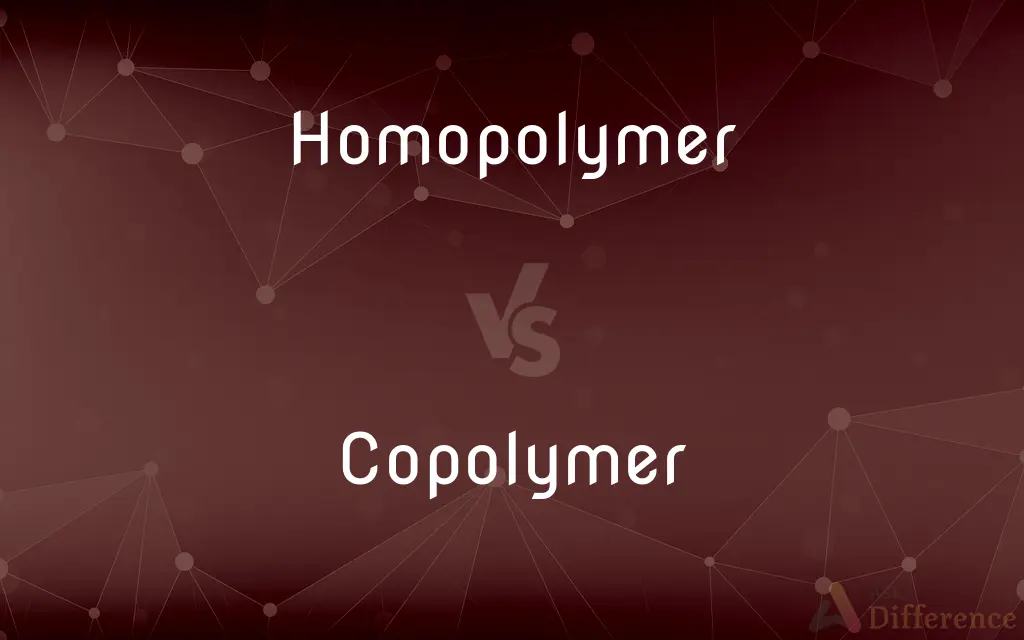Homopolymer vs. Copolymer — What's the Difference?
Edited by Tayyaba Rehman — By Fiza Rafique — Updated on October 10, 2023
Homopolymers consist of a single type of monomer, while copolymers are formed from two or more different monomers.

Difference Between Homopolymer and Copolymer
Table of Contents
ADVERTISEMENT
Key Differences
Homopolymers and copolymers are both classifications within the realm of polymers, which are large molecules made up of repeating subunits known as monomers. The distinction between the two lies in the variety of these monomers. A homopolymer is constructed from only one type of monomer. For instance, polyethylene, a common plastic, is a homopolymer because it is composed solely of ethylene monomers.
Copolymers, in contrast, are formed when two or more different types of monomers are polymerized together. This allows for a vast range of properties and applications. Depending on the arrangement of these monomers, copolymers can exhibit diverse characteristics. For example, styrene-butadiene rubber is a copolymer consisting of both styrene and butadiene monomers.
The structure and characteristics of homopolymers are typically more predictable, given their singular monomer composition. This simplicity can be advantageous for certain applications where uniformity is key. On the other hand, the versatility of copolymers stems from the combination of monomers, granting them a wider range of potential properties and uses.
While homopolymers can often be recognized by their uniform structure and properties, copolymers can be tailored to specific needs by varying the type and ratio of monomers used. This adaptability makes copolymers particularly valuable in industries where specialized materials are required.
Comparison Chart
Definition
Polymer derived from a single type of monomer.
Polymer derived from two or more different types of monomers.
ADVERTISEMENT
Monomer Variety
Singular.
Multiple.
Examples
Polyethylene, Polypropylene.
Styrene-butadiene, Ethylene-vinyl acetate.
Structural Uniformity
Typically more uniform due to the presence of only one type of monomer.
Can vary widely based on monomer type and arrangement.
Application Diversity
Often limited due to singular monomer characteristics.
Diverse, as they can be tailored for specific needs.
Compare with Definitions
Homopolymer
A high molecular weight molecule formed from the repetition of a single monomeric unit.
Homopolymers often exhibit consistent properties due to their singular composition.
Copolymer
A polymer formed from two or more different monomers.
Styrene-butadiene is a copolymer used in the production of car tires.
Homopolymer
A polymer derived entirely from one type of monomer.
Polypropylene is a widely used homopolymer in various industries.
Copolymer
A macromolecule consisting of more than one type of repeating unit.
The characteristics of a copolymer can vary based on its monomeric components.
Homopolymer
A single-constituent polymer.
Polyvinyl chloride is an example of a homopolymer used in pipe manufacturing.
Copolymer
A polymer derived from the combination of different monomers.
Ethylene-vinyl acetate is a copolymer with a variety of applications.
Homopolymer
A macromolecule composed of identical repeating units.
The structure of a homopolymer is typically more uniform.
Copolymer
A multi-constituent polymer.
Acrylonitrile butadiene styrene is a versatile copolymer used in the manufacturing of toys.
Homopolymer
A polymer formed from a single species of monomer.
Polyethylene is a common homopolymer used in packaging.
Copolymer
A complex polymer formed by polymerizing distinct monomers together.
Copolymers offer a wider range of properties than homopolymers.
Homopolymer
(chemistry) a polymer formed from a single type of monomer
Copolymer
A copolymer is a polymer derived from more than one species of monomer. The polymerization of monomers into copolymers is called copolymerization.
Copolymer
A polymer of two or more different monomers.
Copolymer
(chemistry) A polymer derived from more than one species of monomer.
Copolymer
A polymer consisting of two or more different monomers
Common Curiosities
Which offers more versatility in applications, homopolymer or copolymer?
Copolymers, due to their combination of monomers, offer a broader range of properties and applications.
Is polyethylene a homopolymer or copolymer?
Polyethylene is a homopolymer.
Are the properties of homopolymers more predictable than those of copolymers?
Typically, yes, since homopolymers consist of only one type of monomer, leading to more uniform properties.
Are copolymers always made of two monomers only?
No, copolymers can be formed from two or more different types of monomers.
Can a copolymer be made of three different monomers?
Yes, a copolymer can be composed of two or more different monomers.
Why might industries prefer copolymers over homopolymers for certain applications?
Copolymers can be tailored for specific needs by varying the type and ratio of monomers, offering diverse properties.
Is polyvinyl chloride (PVC) a homopolymer or copolymer?
Polyvinyl chloride (PVC) is a homopolymer.
What's a common application of a homopolymer?
A common application of a homopolymer like polyethylene is in packaging.
Is styrene-butadiene rubber a homopolymer or a copolymer?
Styrene-butadiene rubber is a copolymer.
What's the primary distinction between a homopolymer and a copolymer?
Homopolymers consist of a single type of monomer, while copolymers are formed from two or more different monomers.
Can a polymer made from a blend of two homopolymers be termed a copolymer?
No, a blend of two homopolymers is not a copolymer. A copolymer involves co-polymerization of different monomers, not a blend of two homopolymers.
What's the difference in the structural uniformity of homopolymers and copolymers?
Homopolymers are typically more structurally uniform due to the presence of only one type of monomer, while copolymers can vary based on monomer type and arrangement.
Are all copolymers synthetic?
While many commercially used copolymers are synthetic, natural copolymers, like some proteins, do exist.
Can a homopolymer be derived from more than one type of monomer?
No, by definition, a homopolymer is derived from a single type of monomer.
Are the mechanical properties of copolymers always superior to those of homopolymers?
Not necessarily. The mechanical properties of copolymers depend on the types and arrangement of the monomers and may or may not be superior to homopolymers.
Share Your Discovery

Previous Comparison
Twig vs. Stick
Next Comparison
Intelligence vs. CreativityAuthor Spotlight
Written by
Fiza RafiqueFiza Rafique is a skilled content writer at AskDifference.com, where she meticulously refines and enhances written pieces. Drawing from her vast editorial expertise, Fiza ensures clarity, accuracy, and precision in every article. Passionate about language, she continually seeks to elevate the quality of content for readers worldwide.
Edited by
Tayyaba RehmanTayyaba Rehman is a distinguished writer, currently serving as a primary contributor to askdifference.com. As a researcher in semantics and etymology, Tayyaba's passion for the complexity of languages and their distinctions has found a perfect home on the platform. Tayyaba delves into the intricacies of language, distinguishing between commonly confused words and phrases, thereby providing clarity for readers worldwide.













































